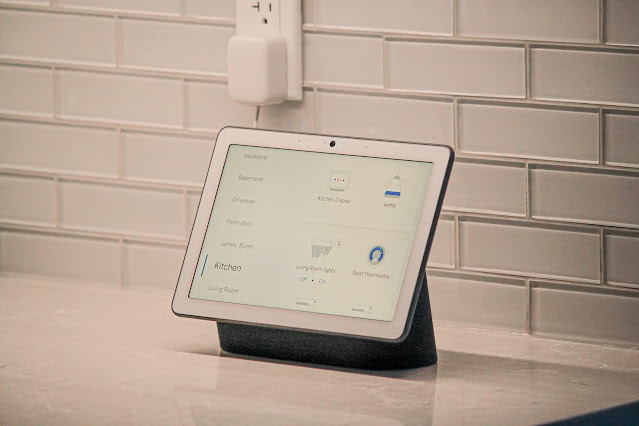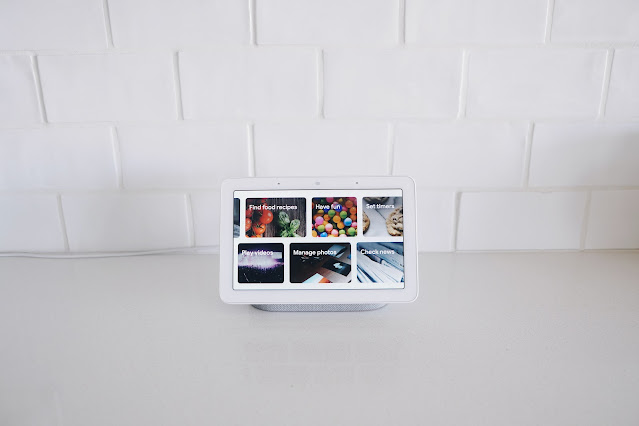More dashboard features
For me, clicking "media" will only display a list of Android TVs and Chromecast targets. This portion of the interface doesn't appear very functional given that you can't truly choose what you want to play on devices. I only have access to a "Play Music" button, which plays random Google Play Music content. Google demonstrated some incredible connectivity with a Dish Hopper DVR, which also resides on this screen, at the launch event. With the Hopper connection, the media area makes a lot more sense because you can go through a list of channels, adjust the level, and receive a full touchscreen control. There isn't much to do with this screen right now if you don't have a Dish Hopper DVR.
The Google Home speakers come with a feature called "Broadcast" that allows you to record a message and send it out to the whole house. There has never been a simpler way to invite the family around for dinner.
You can choose a setting and mode for your thermostat under "Thermostats." Once more, the attractive circular temperature slider UI with the blue/orange color coding for heat and air conditioning appears. I have a Nest Thermostat that is owned by Google, and it functions just fine. The majority of Nest's competitors are all supported as well.
When it comes to smart homes, "Cameras" is an unbelievable compatibility disaster. There isn't really anything out there that even comes close to making it simple to transfer local video between locations, so you wind up with a number of isolated products that are incompatible with one another. Although Google's list includes a few third-party alternatives, this feature primarily supports Google's own Nest cameras, which are astronomically expensive when you consider the monthly charge required to unlock the full capabilities (like, say, recording video). It is incompatible with the Ubiquiti camera system I have. In fact, video may be sent from the Nest Doorbell Camera to the Google Home Hub. It will take control of the screen when the doorbell is pressed.
The last portion, "locks," simply displays a screen with a button to modify the lock state and displays the lock status. The Google Assistant can control my SmartThings setup's lights and thermostats, but not its locks. I can understand why this wasn't included in the voice commands (just picture shouting "Hey Google, unlock the door!" from outside the door). However, lock support would be great now that there is a touch UI. I'm not sure if it indicates whether the door is open or closed because this doesn't function for me (it did not seem to at the event demo).
Rooms
The idea of "rooms," which you set up in advance, is how the Google Assistant operates. This implies that each Google Home and smart home gadget is given a room to be assigned to. By listening to which gadget picks up your voice, the Google Assistant is able to determine which room you are in as well as which devices are nearby. If you ask Assistant to do anything generic, like "turn out the lights," she will only do it for the room you are now in.
This idea is also utilized by the bottom light switches on the main dashboard; they solely regulate the lighting in the current room. The "view rooms" button at the top will provide a list of all the rooms and all the gadgets. You can't configure, fix, or edit any of this on the Home Hub yourself, as I've already indicated, which is annoying. To resolve a problem, you must thoroughly search via the Google Home mobile app.
Amazingly, this covers practically all of the settings and operation of the locks, lights, and thermostat that I change with Action Tiles. Any form of support for routines appears to be the one major feature that is missing. Routines are sizable groups of settings that you can activate with a single command in a smart home setup.Consider a "Good night" routine that includes turning off all the lights, locking all the doors, and adjusting the thermostat. Additionally, you might have a "movie time" schedule that dims some lights simultaneously while turning off others. The Home Hub lacks any form of touchscreen interface to see and activate routines, while you can program routines into the Google Assistant and call them with your voice. A "good night" button would be useful if you want to keep the Home Hub, for example, on your nightstand.
Additionally, I want a smart home ambience mode. Simply allow the smart home control panel to be seen constantly in place of photos or a large clock. Add a clock, perhaps.
Despite these tiny complaints, I genuinely adore the smart home panel. I'm in if this represents Google's intentions for smart displays. Simply put, we require a lot more of it.
Amazing hardware, but perhaps you should wait for the software to catch up.
So, how do you think the functionality is working so far? The smart home dashboard, a photo frame, and recipes are the only things the touchscreen is truly good for. The remaining features are identical to what you can get with a Google Home speaker. If any of those characteristics appeal to you as a killer app when you're already a part of the Google ecosystem, go for it. If you have suitable equipment, the smart home capability is really good.
It's also acceptable to hold off for a year or two to observe how this develops. If you're only interested in voice commands and music right now, a Google Home speaker with poorer sound quality would be a better choice than getting a screen-based device.
If this performs similarly to the other Google Home products, the hardware will endure for a long time and continue to receive updates. This is great news because the equipment is amazing. The design of the smartphone is excellent, and Google really outdid itself with the color-matched, low-light display. It's the first display that doesn't blind you with glare, even when presenting a white background. It is perfectly readable but not unbearably bright so as to shine light into the house. Simply said, the display disappears into the distance.



Post a Comment